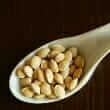Background
- Hyacinth bean (Lablab spp.) is found in tropical areas, where it is commonly used as a food crop. Hyacinth bean has also been used as a medicine, poison, or fertilizer, and for ornamental purposes.
- Hyacinth bean has been shown to decrease the risk of bleeding and may have contraceptive, insecticide, nutrition enhancement, antioxidant, and antiviral effects, however, there is currently a lack of human trials in these areas. Further research is necessary before conclusions may be made regarding using hyacinth bean for any condition.
References
- Abeke FO, Ogundipe SO, Sekoni AA, et al. Growth and subsequent egg production performance of shika-brown pullets fed graded levels of cooked Lablab purpureus beans. Pak J Biol Sci 2007;10(7):1056-1061. View Abstract
- Baligar VC, Fageria NK, Paiva AQ, et al. Light intensity effects on growth and micronutrient uptake by tropical legume cover crops. Journal of Plant Nutrition 2006;29(11):1958-1974.
- Gubesch M, Theler B, Dutta M, et al. Strategy for allergenicity assessment of 'natural novel foods': clinical and molecular investigation of exotic vegetables (water spinach, hyacinth bean and Ethiopian eggplant). Allergy 2007;62(11):1243-1250. View Abstract
- Janarthanan S, Suresh P, Radke G, et al. Arcelins from an Indian wild pulse, Lablab purpureus, and insecticidal activity in storage pests. J Agric.Food Chem 2008;56(5):1676-1682. View Abstract
- Kanade SR, Rao DH, Hegde RN, et al. The unique enzymatic function of field bean (Dolichos lablab) D-galactose specific lectin: a polyphenol oxidase. Glycoconj J 2009;26(5):535-545. View Abstract
- Kim YH, Woloshuk CP, Cho EH, et al. Cloning and functional expression of the gene encoding an inhibitor against Aspergillus flavus alpha-amylase, a novel seed lectin from Lablab purpureus (Dolichos lablab). Plant Cell Rep 2007;26(4):395-405. View Abstract
- Kone AW, Tondoh JE, Bernhard-Reversat F, et al. Changes in soil biological quality under legume- and maize-based farming systems in a humid savanna zone of Côte d'Ivoire. Biotechnol Agron Soc 2008;12(2):147-155.
- Latha VL, Rao RN, Nadimpalli SK. Affinity purification, physicochemical and immunological characterization of a galactose-specific lectin from the seeds of Dolichos lablab (Indian lablab beans). Protein Expr Purif 2006;45(2):296-306. View Abstract
- Qureshi SA, Midmore DJ, Syeda SS, et al. A comparison of alternative plant mixes for conservation bio-control by native beneficial arthropods in vegetable cropping systems in Queensland Australia. Bull Entomol Res 2010;100(1):67-73. View Abstract
- Rameshwaram NR, Karanam NK, Scharf C, et al. Complete primary structure of a newly characterized galactose-specific lectin from the seeds of Dolichos lablab. Glycoconj J 2009;26(2):161-172. View Abstract
- Schellenberger DL, Morse RD, Welbaum GE. Organic broccoli production on transition soils: Comparing cover crops, tillage and sidedress N. Renewable Agriculture & Food Systems 2009;24(2):85-91.
- Sufian MK, Hira T, Asano K, et al. Peptides derived from dolicholin, a phaseolin-like protein in country beans (Dolichos lablab), potently stimulate cholecystokinin secretion from enteroendocrine STC-1 cells. J Agric Food Chem 2007;55(22):8980-8986. View Abstract
- Vanlauwe B, Idrissa A, Diels J, et al. Plant age and rock phosphate effects on the organic resource quality of herbaceous legume residues and their N and P release dynamics. Agron Sustain Dev 2008;28(3):429-437.
- Vera-Nunez JA, Infante-Santiago JP, Velasco V, et al. Influence of P Fertilization on Biological Nitrogen Fixation in Herbaceous Legumes Grown in Acid Savannah Soils from the Tabasco State, Mexico. Journal of Sustainable Agriculture 2008;31(3):25-42.
- Yao H, Xie X, Li Y, et al. Legume lectin FRIL preserves neural progenitor cells in suspension culture in vitro. Clin Dev Immunol 2008;2008:531317. View Abstract







